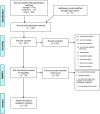From research to clinical practice: a systematic review of the implementation of psychological interventions for chronic headache in adults
- PMID: 32450871
- PMCID: PMC7247180
- DOI: 10.1186/s12913-020-05172-y
From research to clinical practice: a systematic review of the implementation of psychological interventions for chronic headache in adults
Abstract
Background: Psychological interventions have been proved to be effective in chronic headache (CH) in adults. Nevertheless, no data exist about their actual implementation into standard clinical settings. We aimed at critically depicting the current application of psychological interventions for CH into standard care exploring barriers and facilitators to their implementation. Secondarily, main outcomes of the most recent psychological interventions for CH in adults have been summarized.
Methods: We conducted a systematic review through PubMed and PsycINFO in the time range 2008-2018. A quality analysis according to the QATSDD tool and a narrative synthesis were performed. We integrated results by: contacting the corresponding author of each paper; exploring the website of the clinical centers cited in the papers.
Results: Of the 938 identified studies, 28 papers were selected, whose quality largely varied with an average %QATSDD quality score of 64.88%. Interventions included CBT (42.85%), multi-disciplinary treatments (22.43%), relaxation training (17.86%), biofeedback (7.14%), or other interventions (10.72%). Treatments duration (1 day-9 months) and intensity varied, with a prevalence of individual-basis implementation. The majority of the studies focused on all primary headaches; 4 studies focused on medication-overuse headache. Most of the studies suggest interventions as effective, with the reduction in frequency of attacks as the most reported outcome (46.43%). Studies were distributed in different countries, with a prevalent and balanced distribution in USA and Europe. Ten researches (35.71%) were performed in academic contexts, 11 (39.28%) in clinical settings, 7 (25%) in pain/headache centres. Interventions providers were professionals with certified experience. Most of the studies were funded with private or public funding. Two contacted authors answered to our e-mail survey, with only one intervention implemented in the routine clinical practice. Only in three out of the 16 available websites a reference to the implementation into the clinical setting was reported.
Conclusion: Analysis of contextual barriers/facilitators and cost-effectiveness should be included in future studies, and contents regarding dissemination/implementation of interventions should be incorporated in the professional training of clinical scientists. This can help in filling the gap between the existing published research and treatments actually offered to people with CH.
Keywords: Acceptance and commitment therapy (ACT); Behavioral interventions; Biofeedback (BFB); Chronic headache; Cognitive-behavioral therapy (CBT); Migraine; Mindfulness; Psychological interventions; Relaxation training; Tension-type headache.
Conflict of interest statement
The authors declare that they have no competing interests.
Figures
Similar articles
-
The future of Cochrane Neonatal.Early Hum Dev. 2020 Nov;150:105191. doi: 10.1016/j.earlhumdev.2020.105191. Epub 2020 Sep 12. Early Hum Dev. 2020. PMID: 33036834
-
The Effectiveness of Integrated Care Pathways for Adults and Children in Health Care Settings: A Systematic Review.JBI Libr Syst Rev. 2009;7(3):80-129. doi: 10.11124/01938924-200907030-00001. JBI Libr Syst Rev. 2009. PMID: 27820426
-
Psychological interventions to improve self-management of type 1 and type 2 diabetes: a systematic review.Health Technol Assess. 2020 Jun;24(28):1-232. doi: 10.3310/hta24280. Health Technol Assess. 2020. PMID: 32568666 Free PMC article.
-
Psychological Interventions for Pediatric Headache Disorders: A 2021 Update on Research Progress and Needs.Curr Pain Headache Rep. 2022 Jan;26(1):85-91. doi: 10.1007/s11916-022-01007-z. Epub 2022 Feb 2. Curr Pain Headache Rep. 2022. PMID: 35107711 Free PMC article. Review.
-
Beyond the black stump: rapid reviews of health research issues affecting regional, rural and remote Australia.Med J Aust. 2020 Dec;213 Suppl 11:S3-S32.e1. doi: 10.5694/mja2.50881. Med J Aust. 2020. PMID: 33314144
Cited by
-
eHealth-Integrated Psychosocial and Physical Interventions for Chronic Pain in Older Adults: Scoping Review.J Med Internet Res. 2024 Jul 29;26:e55366. doi: 10.2196/55366. J Med Internet Res. 2024. PMID: 39073865 Free PMC article.
-
Exploring Emotional Distress, Psychological Traits and Attitudes in Patients with Chronic Migraine Undergoing OnabotulinumtoxinA Prophylaxis versus Withdrawal Treatment.Toxins (Basel). 2020 Sep 8;12(9):577. doi: 10.3390/toxins12090577. Toxins (Basel). 2020. PMID: 32911799 Free PMC article.
-
Network Analysis Reveals That Headache-Related, Psychological and Psycho-Physical Outcomes Represent Different Aspects in Women with Migraine.Diagnostics (Basel). 2022 Sep 26;12(10):2318. doi: 10.3390/diagnostics12102318. Diagnostics (Basel). 2022. PMID: 36292007 Free PMC article.
-
Understanding the interaction between clinical, emotional and psychophysical outcomes underlying tension-type headache: a network analysis approach.J Neurol. 2022 Aug;269(8):4525-4534. doi: 10.1007/s00415-022-11039-5. Epub 2022 Mar 1. J Neurol. 2022. PMID: 35229190
-
Non-Pharmacological Approaches to Headaches: Non-Invasive Neuromodulation, Nutraceuticals, and Behavioral Approaches.Int J Environ Res Public Health. 2021 Feb 5;18(4):1503. doi: 10.3390/ijerph18041503. Int J Environ Res Public Health. 2021. PMID: 33562487 Free PMC article. Review.
References
-
- Stovner LJ, Hagen K, Jensen R, Katsarava Z, Lipton RB, Scher AI, et al. The global burden of headache: a documentation of headache prevalence and disability worldwide. Cephalalgia. 2007;27(3):193–210. - PubMed
-
- World Health Organization (WHO). Lifting the burden. Atlas of headache disorders and resources in the world 2011: WHO; 2011.
-
- HCC-HIS 2013-Headache Classification Committee of the International Headache Society The international classification of headache disorders, 3rd edition (beta version) Cephalalgia. 2013;33(9):629–808. - PubMed
Publication types
MeSH terms
LinkOut - more resources
Full Text Sources
Medical
Miscellaneous



